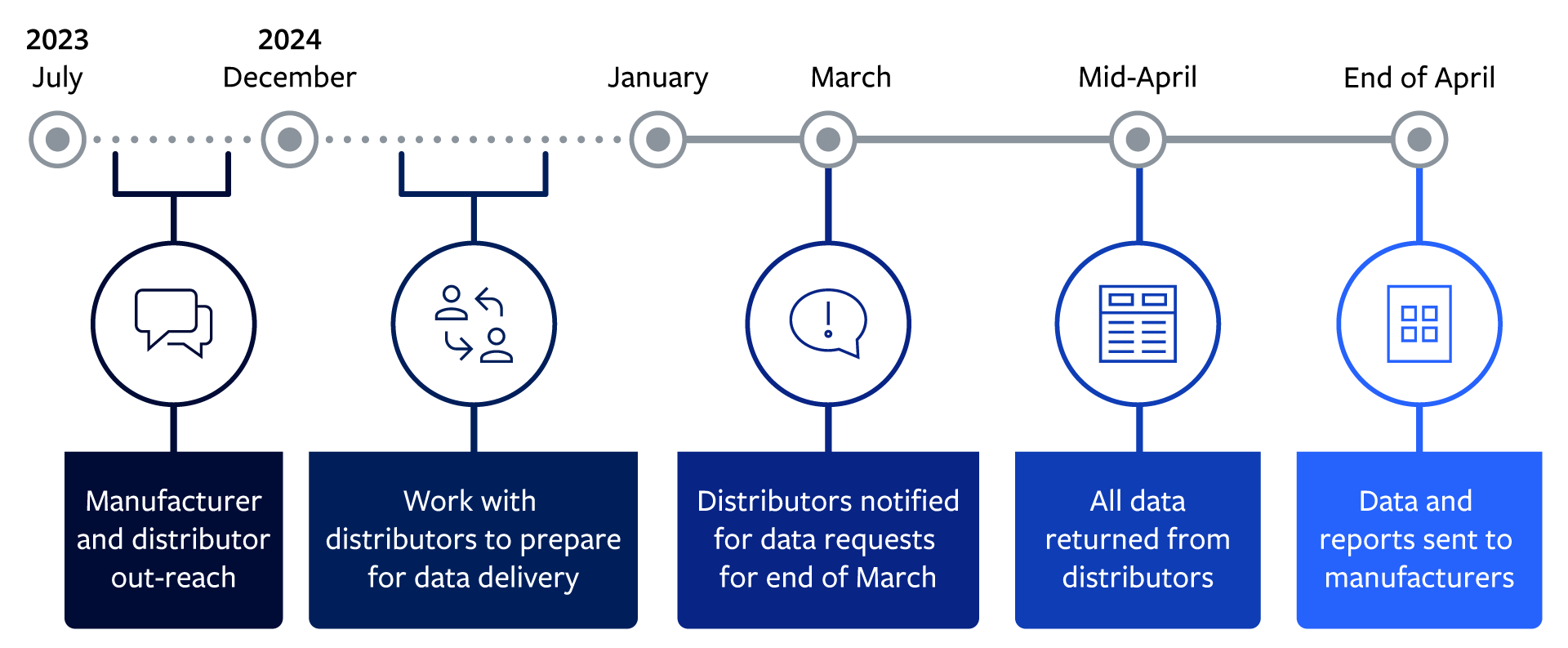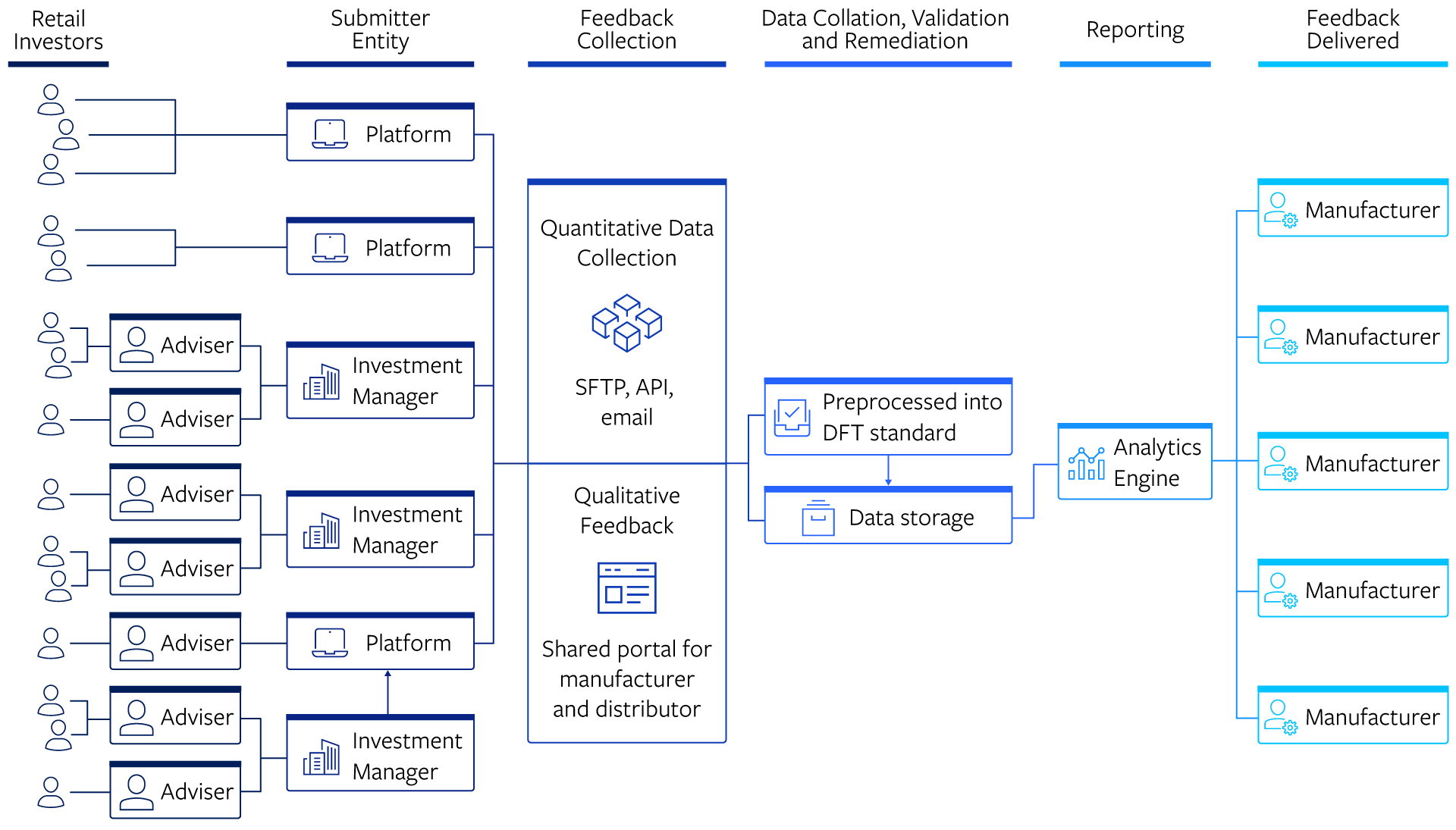Consumer Duty: The approach to distributor-to-manufacturer feedback
Introduction
The FCA’s recent Consumer Duty has joined the ranks of other regulations, such as MiFID II , to create a culture within the industry aimed at protecting consumers and prioritising their needs. Under the section “PRIN 2A.3 retail customer outcome - products and services” there is a requirement for manufacturers to regularly review their products. This has created an obligation for distributors to provide information to manufacturers to assist in their product review processes. Fast approaching is a logistical headache in the lead up to March 2024 as asset managers and platforms scramble to come to terms with the realities of this feedback loop.
The Challenge
As an industry we have become comfortable with the established flow of product information from manufacturers to distributors and surely a simple reversal of this process cannot be too problematic, can it? The FCA has made it noticeably clear in FG22/5 that is expects industry co-operation with failure resulting in a breach of regulation:
- 2.22 Distributor firms are required to share information to support manufacturers when reviewing products or services. Where firms do not comply with this requirement, they may therefore be in breach of the Duty.
- 6.68 To support manufacturers’ reviews, distributors must, upon request, provide relevant information, including, where appropriate, sales information, information on cancellations, and information on the regular reviews of their distribution arrangements.
- 6.69 The requirement to provide information to support manufacturer reviews applies to all distributor firms in the distribution chain. We expect all firms in a distribution chain to co-operate.
The Distributor Feedback Template
To keep distributors and manufactures compliant with Consumer Duty a working group from the Joint Trade Association has created the Distributor Feedback Template (DFT) along with supporting guidelines. This template will go a long way to being the panacea for the operational predicament facing the industry. By normalising the flow of information and creating an industry standard for the quality of feedback, the DFT will be a vital component to the new process. Becoming savvy with the template will be essential and guidance has been issued as to how firms should approach use of the DFT.
For a more detailed look at this advice please use the following link:
The working group has also broken the process into two categories:
Quantitative Data
This is data which is capable of being automated or standardised (subject to the limitations noted below) for periodic reporting such as sales data, sales outside target market, holdings data and redemptions. The FCA has stated that it expects to see an information flow and to this extent there is an intention that quantitative data should be automated. Manufacturers will be looking for a technology provider that can supply a robust stream of validated data collated from a multitude of distributors.
Qualitative Data
This is data which should be notified to manufacturers as and when specific events arise and which may require detail or narrative that cannot be automated or standardised such as distribution issues, complaints, and poor outcomes.
Qualitative data may require firms to put in place internal processes around communications and may find it necessary to collaborate with a partner who can assist in capturing and sharing the qualitative feedback. 
Timeframes
The Joint Trade Association anticipates that the first tranche of distributor reporting will be delivered to manufacturers within six weeks of the end of March 2024 and will include data from the previous eight months. Subsequent reporting will be provided at six monthly intervals, to align with Board reporting and Annual reporting cycles.
The focus now will be for the distributors to embrace the template and establish their position in the distribution chain. To clarify this the working group has classified distributors as:
- Submitter Entities: the entity that completes the report and delivers it to the manufacturer.
- Intermediate distributors: the entity that is closest to the manufacturer in a multi-distributor chain.
- End distributors: the entity whose action results in the sale of the product.
The Joint Trade Association has provided guidance in order to clarify some of the complexities of the process. Firms may be considered “End Distributors” as well as “Intermediate Distributors” for different parts of their business. For example, in one scenario a firm could operate directly with clients as well as providing an adviser platform.In this case a “Submitter Entity” would need to provide data for each of the Manufacturer's products that it holds as an “End Distributor” and in addition to this, supply data for each of the Manufacturer's products as an “Intermediate Distributor” with a separate entry, for each underlying End Distributor.

The Future of DFT
The uptake of the Distributor Feedback Template will now be the focus of all parties involved in data transfer. In a recent survey by Deloitte 37% of distributors have already committed to use the industry feedback standard. This is an incredibly positive indicator at this initial stage and from the conversations Broadridge has had with market participants, the number is steadily increasing.
The success of the DFT and its endeavour to keep firms compliant with Consumer Duty will depend on the ability to overcome the logistical difficulties of implementing it effectively.
As a result of these discussions Broadridge has identified several key requirements to simplify and streamline reporting for Consumer Duty.
- The ability to collect and aggregate data in multiple formats from numerous sources.
- The necessity to ensure that the data is validated and that any anomalous figures are flagged.
- A system to manage the vast number of feedback requests and responses.
- A process for reporting on the delivery of data and demonstrating compliance.
The Broadridge offering goes beyond data collection and delivery. Broadridge has developed a suite of analytics to overlay the feedback data. These analytics will deliver actionable insights from the first reporting period but will become even more beneficial as more data is added and meaningful trend analysis can be derived from the feedback data.
Let’s talk about what’s next for you
Our representatives and specialists are ready with the solutions you need to advance your business.
Want to speak with a sales representative?
| Table Heading | |
|---|---|
| +1 800 353 0103 | North America |
| +442075513000 | EMEA |
| +65 6438 1144 | APAC |
Thank you.
Your sales rep submission has been received. One of our sales representatives will contact you soon.
Want to speak with a sales representative?
| Table Heading | |
|---|---|
| +1 800 353 0103 | North America |
| +442075513000 | EMEA |
| +65 6438 1144 | APAC |
